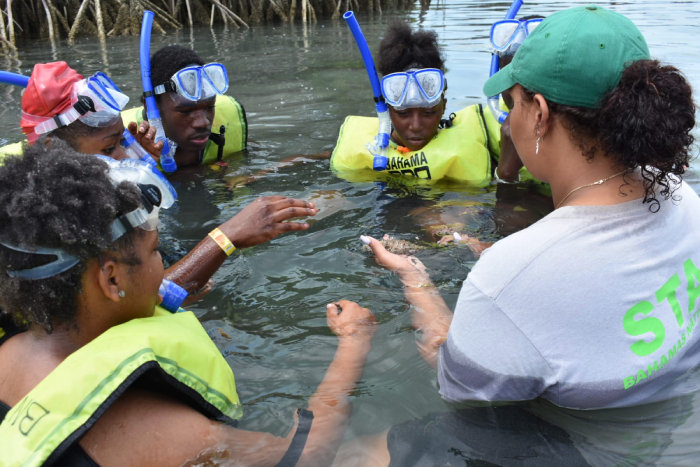Bonefish Pond National Park
est. 2002
About
What stands as the last remaining tidal mangrove ecosystem on the shores of Southern New Providence, Bonefish Pond protects 1,235 acres of important coastal wetlands. This national park is home to a wide diversity of birds and is an important nursery for many marine species that are important to the country. With a boardwalk extending out into the mangroves, this park is a great spot for both recreation and education and is the most visited national park on the island.

Boardwalks and Trails
There are access boardwalks and trails in this park.

Bird Hotspot
This park has high bird activity.

Popular Attraction
This park is a popular tourist attraction.

Security
Security on weekends, but no daily active patrol wardens.
Admission
No entry fee
BNT tour guides are available only by arrangement
Park Hours
Fridays, Saturdays, Sundays & *Public Holidays
9:00am – 4:00pm
*Excluding during the Christmas and New Years related holidays
A WETLAND WONDER.
Bonefish Pond is 1,235 acres of coastal wetland area. This is a park where teachers and students alike can see and learn about the different marine life that call Bonefish pond home.


Youth learning about wildlife (sea cucumber) at Bonefish Pond.
AN OUTDOOR CLASSROOM
Bonefish Pond National Park makes the perfect outdoor classroom where students can learn about mangroves and wetland ecosystems in The Bahamas. The 600-foot boardwalk takes visitors into the robust mangrove wetland and was built over the sensitive, muddy bottom substrate. It makes viewing the many birds, fish and other critters that call this place home easy. If you’re lucky, on a calm day you can observe small schools of bonefish feeding, which is how this park got its name. There are two sections of the boardwalk where visitors can step down and enter the wetland at low tide. However, we only encourage this when it is supervised to avoid accidents and major disturbances to the ecosystem.
CHANGING TIDES
Like many other tidal ecosystems, as there are changes in tide, the ecosystem itself changes. In BFPNP, the difference in tide provides visitors with different experiences. At high tide, you can kayak through the mangroves and see this beautiful ecosystem up close. You can also step into the water and snorkel throughout the system and see the abundance of marine animals that inhabit this system. During low tide, many species of wading and wetland birds come out to feed. Birders and nature enthusiasts alike can see and hear the presence of over 50 bird species! As one of the few undeveloped sections of the coast of New Providence Island, the park is recognized as a place for peace and solitude where one can experience natural sounds, with minimum human disturbance.

Clapper rails are common visitors to the park at low tide.
HISTORY
Wetlands, Not Wastelands.
For decades, wetlands have been considered by many as wastelands – a place to discard trash. The BFPNP, historically, was a popular dumping ground for some people in the surrounding communities. The BNT realized this valuable mangrove ecosystem was endangered by the excessive dumping, which eventually would have destroyed the area. The BNT along with numerous volunteers started major cleanup efforts to restore this beautiful area. What is now the parking lot was once the major spot for dumping, littered with mountains of debris.

Dumping in Bonefish Pond, 2012
Along with the illegal dumping problem, nearshore marine habitats, including mangrove creeks, seagrass meadows, and sandy shores are the most vulnerable to coastal zone development and harvest of nearshore resources. These habitats are critical in the juvenile and adult life stages of many ecologically, economically, and culturally important fish and invertebrate species in the Bahamas, including groupers, snappers, grunts, bonefish, barracuda, crawfish and queen conch. Furthermore, they are important to many species of wetland birds and provide additional ecosystem services.

Dredging near Bonefish Pond
Faced with these threats, the Government of the Bahamas created the Bonefish Pond National Park in 2002 to safeguard one of the largest remaining intact areas of nearshore marine ecosystems around New Providence Island. To date, the Bahamas National Trust has made improvements to the access to the park and infrastructure by improving road access to the park, creating a parking area and building a boardwalk through the mangroves to increase public access to the park.
The BNT has led many cleanup efforts, engaging local and international groups in debris removal, mangrove planting, and other restoration efforts. Due to its proximity to local communities, and the absence of a stationed warden, The BNT is still battling minor illegal dumping issues.

Restoration efforts in Bonefish Pond by Rotary New Providence.
Stories about Blue Holes National Park





